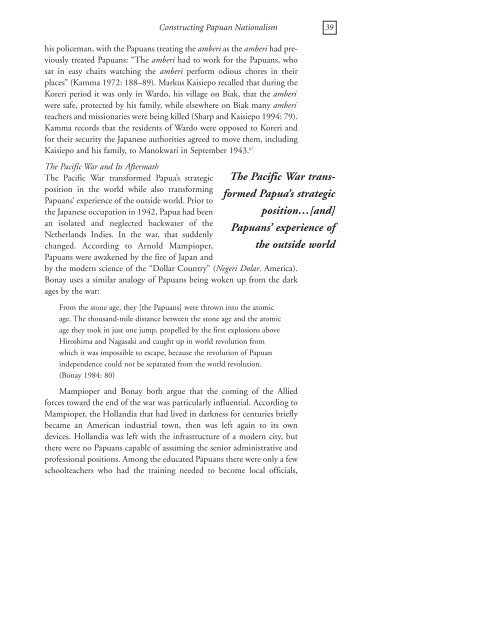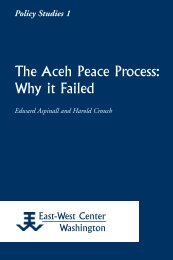Constructing Papuan Nationalism: History, Ethnicity ... - ScholarSpace
Constructing Papuan Nationalism: History, Ethnicity ... - ScholarSpace
Constructing Papuan Nationalism: History, Ethnicity ... - ScholarSpace
- No tags were found...
Create successful ePaper yourself
Turn your PDF publications into a flip-book with our unique Google optimized e-Paper software.
<strong>Constructing</strong> <strong>Papuan</strong> <strong>Nationalism</strong> 39his policeman, with the <strong>Papuan</strong>s treating the amberi as the amberi had previouslytreated <strong>Papuan</strong>s: “The amberi had to work for the <strong>Papuan</strong>s, whosat in easy chairs watching the amberi perform odious chores in theirplaces” (Kamma 1972: 188–89). Markus Kaisiepo recalled that during theKoreri period it was only in Wardo, his village on Biak, that the amberiwere safe, protected by his family, while elsewhere on Biak many amberiteachers and missionaries were being killed (Sharp and Kaisiepo 1994: 79).Kamma records that the residents of Wardo were opposed to Koreri andfor their security the Japanese authorities agreed to move them, includingKaisiepo and his family, to Manokwari in September 1943. 67The Pacific War and Its AftermathThe Pacific War transformed Papua’s strategicposition in the world while also transforming<strong>Papuan</strong>s’ experience of the outside world. Prior tothe Japanese occupation in 1942, Papua had beenan isolated and neglected backwater of theNetherlands Indies. In the war, that suddenlychanged. According to Arnold Mampioper,<strong>Papuan</strong>s were awakened by the fire of Japan andby the modern science of the “Dollar Country” (Negeri Dolar. America).Bonay uses a similar analogy of <strong>Papuan</strong>s being woken up from the darkages by the war:The Pacific War transformedPapua’s strategicposition…[and]<strong>Papuan</strong>s’ experience ofthe outside worldFrom the stone age, they [the <strong>Papuan</strong>s] were thrown into the atomicage. The thousand-mile distance between the stone age and the atomicage they took in just one jump, propelled by the first explosions aboveHiroshima and Nagasaki and caught up in world revolution fromwhich it was impossible to escape, because the revolution of <strong>Papuan</strong>independence could not be separated from the world revolution.(Bonay 1984: 80)Mampioper and Bonay both argue that the coming of the Alliedforces toward the end of the war was particularly influential. According toMampioper, the Hollandia that had lived in darkness for centuries brieflybecame an American industrial town, then was left again to its owndevices. Hollandia was left with the infrastructure of a modern city, butthere were no <strong>Papuan</strong>s capable of assuming the senior administrative andprofessional positions. Among the educated <strong>Papuan</strong>s there were only a fewschoolteachers who had the training needed to become local officials,
















